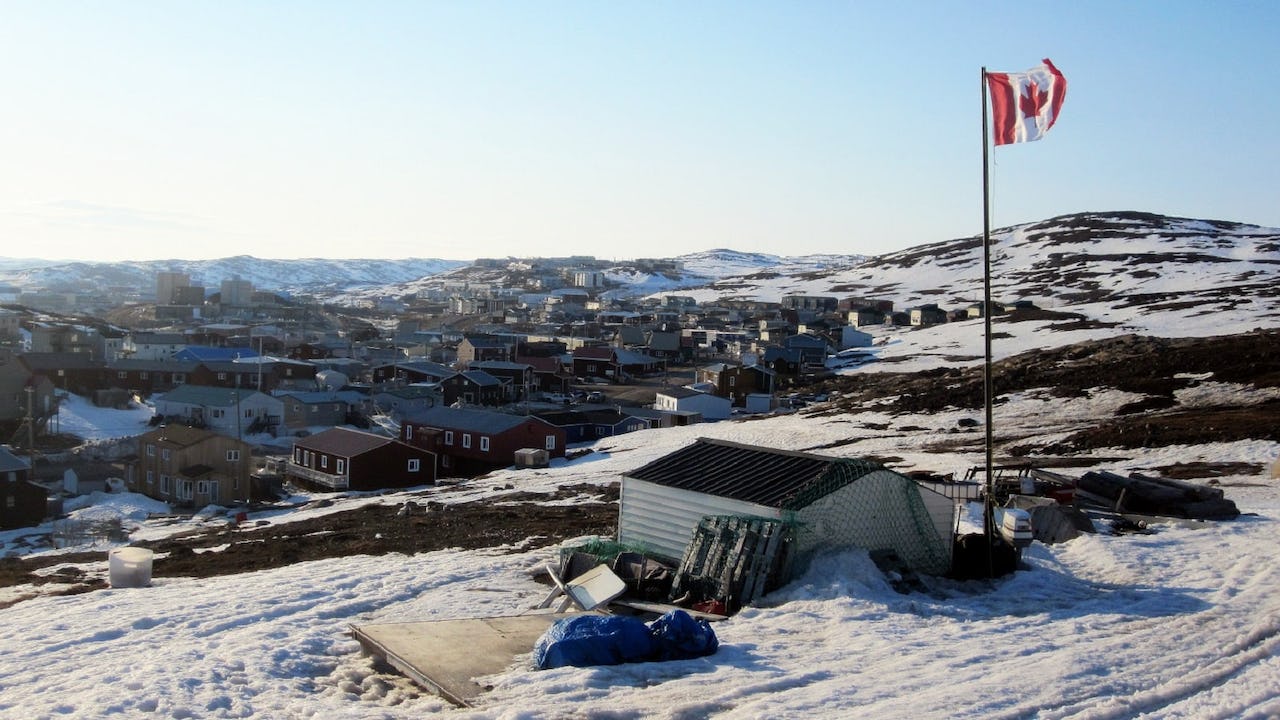The Arctic Institute Colonialism Series 2022: Introduction

The Canadian flag flies over Iqaluit, where 59.4% of the population is comprised of Indigenous peoples. Photo: Aaron M. Lloyd
The Arctic is becoming an increasingly prominent topic in both political and academic fields. There are more and more discussions of conserving the Arctic environment, defending Arctic territory, and securing Arctic infrastructure. But these discussions raise a critical question: In a region with ongoing legacies of colonialism, just whose Arctic do we aim to protect?
Indigenous peoples have resided in the Arctic since time immemorial, establishing rich regional cultures long before the development of colonial settlements and nation-state borders. Today, the Arctic is home to 40 distinct ethnic groups and 40 to 90 languages, with Indigenous peoples comprising approximately 10 percent of the total population. Traditional knowledge has proven valuable in understanding climate change, food security, and other regional issues, highlighting the critical role Indigenous peoples play in both historic and contemporary Arctic governance.
Colonial histories of the Arctic are diverse and complex. Historic powers including France, Great Britain, Denmark-Norway,1) and the Russian Empire claimed and traded Arctic territories inhabited by Indigenous peoples. In some cases, processes of Arctic colonialism were bloody, exploitative, and arguably genocidal. Subsequent regimes continue to—partly or fully—govern Arctic territories, even as Indigenous rights to self-determination increase in many nations.
Six of the eight Arctic countries–Canada, Iceland, Denmark, Norway, Sweden, and Finland–have endorsed the United Nations Declaration on the Rights of Indigenous Peoples (UNDRIP). This Declaration requires the free and informed consent of Indigenous persons “prior to the approval of any project affecting their lands or territories and other resources,” raising important jurisdictional questions with regard to governance and economic development in the changing Arctic. Although it has not endorsed UNDRIP through the implementation of domestic legislation, the United States supports the Declaration as an aspirational document. Russia maintains that existing domestic provisions exceed those outlined in UNDRIP and thus make the Declaration unnecessary.
At the international level, the Arctic Council has granted Permanent Participant status to six Indigenous Peoples’ groups: the Aleut International Association, Arctic Athabascan Council, Gwich’in Council International, Inuit Circumpolar Council, Russian Association of Indigenous Peoples of the North, and Saami Council. These Permanent Participants “have full consultation rights in connection with the Council’s negotiations and decisions,” representing a significant step forward for the inclusion of Indigenous peoples in global governance.
Despite growing participation in both domestic and regional governance, at least some Arctic Indigenous peoples remain underserved by modern colonial governments. For example, Greenland consistently reports some of the highest suicide rates in the world and the rate of tuberculosis among Inuit in Canada is over 283 times higher than the national average. These and similar cases highlight the need for a fuller understanding of Indigenous issues in Arctic contexts; an understanding that prioritizes the distinct perspectives, contributions, and needs of northern communities.
The Arctic Institute Colonialism Series 2022 brings together Indigenous and non-Indigenous authors to offer insights on the colonial histories of Arctic nations—and the still—evolving relationships between Arctic Indigenous peoples and settler governments. Luke Laframboise investigates the colonial implications of the European Union’s “Green New Deal” on Indigenous peoples of northern Fenno-Scandia. Gabriella Gricius then argues that colonial legacies impact contemporary security policy of Arctic nations. Next, Seira Duncan provides a musical perspective on poverty and wellbeing among Inuit in the Canadian territory of Nunavut.
Maria Fedina traces the history of the minoritization of the Komi People of modern-day Russia, while Kara K. Hodgson looks at Russia’s policies of domestic colonialism. John Last then examines efforts by the Church of Sweden to reconcile with the Sámi. Samuel Kramer reconsiders the Alaska Purchase through a lens of colonialism and Indigenous sovereignty.
Pedro Allemand Mancebo Silva analyzes the recent and ongoing Arctic resource boom as a new wave of settler colonialism. Maya Crawford, Jayde Lavoie, and Reanne Bremner assess reproductive justice for Arctic Indigenous communities in the context of colonial genocide. Finally, Joaquim Gaignard evaluates China’s engagement with Arctic Indigenous peoples.
Topics addressed in these articles are often sensitive and difficult. In some cases, the authors challenge preexisting ideas about certain Arctic governments and the conditions under which their citizens live. More than anything, the discussions presented in this series are insightful, important—and critically urgent as we look towards the future of a changing Arctic.
References